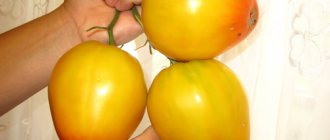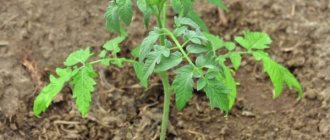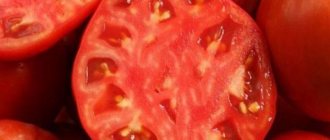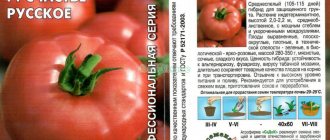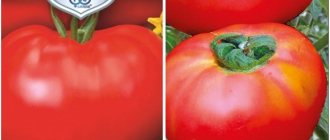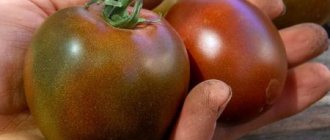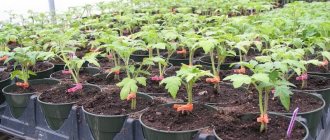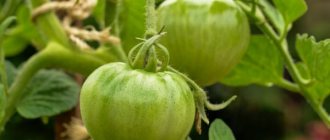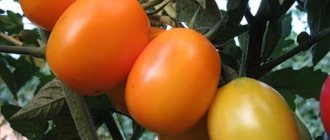Description of the variety
Short review:
The bush is standard, indeterminate, quite tall - from 140 to 180 cm. "Red Giant" is a mid-early variety - the fruits ripen 100-105 days after planting the seedlings in the garden or greenhouse.
Main characteristics of the fruits of the review variety:
- Round, slightly flattened shape;
- Rich, bright red color of ripe tomatoes;
- Excellent taste and aroma;
- Very large fruits - 450-650 grams. First harvest tomatoes can weigh 700-850 grams;
- 6-8 seed chambers;
REFERENCE: The harvested crop is not stored for very long, so it should be immediately eaten or sent for processing.
- A large amount of vitamins and minerals;
- The dry matter content reaches 5%.
Description and characteristics of the Giant tomato variety, reviews, photos
Mid-season, semi-determinate, large-fruited tomato variety for open ground and greenhouses.
up to 1.5 meters high in the greenhouse , lower in the greenhouse. Requires tying to the support and pinning. The best results were obtained when forming a plant with 1 or 2 stems. In the first case, all side shoots (stepchildren) are removed without exception, in the second case, 1 stepson is left under the first flower cluster.
Basic qualities of fruits
The fruits are flat-round, slightly ribbed at the stalk, in the ripe stage of rich red color, weighing 250-500 grams , fleshy, very tasty. These tomatoes are good for fresh consumption, making juices and sauces.
If you form a plant into 1 stem and normalize the amount of ovary, you can get fruits weighing up to 1 kg!
Productivity : at least 3 kg of fruits per plant (with proper agricultural technology).
Advantages of the variety : resistant to fruit cracking and sudden temperature changes.
The Gigant tomato variety is included in the State Register of the Russian Federation for cultivation in open ground under film covers on private farms.
Seed producer : Aelita agricultural company.
This is a natural variety of tomato. Therefore, we recommend taking seeds from a ripe fruit and using them for planting in subsequent seasons.
Growing tomatoes
The "Giant Red" variety is grown by planting seedlings in unprotected soil, under film and in greenhouses.
How to prepare seeds?
For planting, you should select only whole, dense seeds that are not damaged by fungi and insects. Planting material is placed for 30 minutes in a weak solution of potassium permanganate for disinfection, and then washed with clean water.
IMPORTANT: Treating seeds with growth stimulants will increase their germination.
Sowing seed material
It is necessary to sow seeds at the end of February or mid-March. It is recommended to prepare the soil in advance or purchase it in specialized stores. First pour drainage and then soil onto the bottom of the container. Before sowing, the soil needs to be moistened and small grooves made in which to plant the seeds.
The planting is covered with thin glass or plastic film.
After the sprouts appear, the glass is removed and the containers are moved to a sunny place.
Seedlings are picked into separate pots after 2-3 true leaves appear. Seedlings should be watered regularly and fed with liquid mineral fertilizers before planting in the beds.
Rules for planting seedlings
Plants are moved to their permanent place of growth at the age of 55-60 days. The soil on the site is fertilized with old humus or bird droppings diluted in water. The seedlings are placed in holes, at the bottom of which there is superphosphate or sifted wood ash.
For 1 sq. It is recommended to plant no more than three plants per meter.
Description of fruits
The pulp of the Pink Giant or Orange variety tomatoes is fleshy, and at the same time quite juicy - the characteristic corresponds to reality. Unfortunately, each tomato contains up to hundreds of seeds inside. This is the second reason not to can these tomatoes.
Leningrad giant tomatoes are primarily suitable for fresh consumption, and secondarily for processing. They make wonderful juice of moderate thickness. Tomato paste, sauces, seasonings, and ketchups are also made from the Pink Giant.
You should not preserve these tomatoes, even if you found a container with a very wide neck or selected small-sized fruits. The fact is that during heat treatment the skin immediately cracks and the flesh quickly spreads out.
True, some, especially older, summer residents say that they salted Novikov’s giant tomato and the Altai masterpiece in wooden barrels. The fact is that, according to the descriptions, the fresh variety does not last long, so they preserve it so that it does not disappear.
Bush care
Basic tips for caring for “Giant Red” tomatoes:
- Regular watering at the root with warm and settled water;
- Loosening the soil in the beds;
- Weeding and removal of tops;
The bushes respond very well to a variety of feedings at all stages of formation and growth.
- Feeding with organic matter and nutritional mineral complexes.
The bush should be formed into two or three stems (in unprotected soil, usually three). The stem must be tied to supports, and branches with heavy fruits must be strengthened with pegs or supports.
Characteristics
These tomatoes are not suitable for whole-fruit canning due to the large size of the fruits, but you can make barrel pickles. Red giant tomatoes are very good fresh. Juices, purees and pastes are very good due to the high content of sugars and vitamins.
Although this variety is a “giant”, its yield is very modest. Under good conditions, you can collect 3-4 kg from each bush. With a recommended planting density of 3 plants per square meter. m comes out to 12 kg . This is far from a record, especially for such a tall bush.
You can compare the yield of Giant red tomatoes with others below:
| Variety name | Productivity |
| Giant red | 3-4 kg per bush |
| Gulliver | 7 kg per bush |
| Pink Lady | 25 kg per square meter |
| Fat Jack | 5-6 kg per bush |
| Doll | 8-9 kg per square meter |
| Lazy | 15 kg per square meter |
| Black bunch | 6 kg per bush |
| Rocket | 6.5 kg per square meter |
| Brown sugar | 6-7 kg per square meter |
| King of Kings | 5 kg per bush |
Diseases and pests
The review variety has good immunity to dangerous diseases. However, due to improper care, plants can be damaged by fungus.
When growing in protected soil, it is necessary to observe the lighting and watering regime, as well as regularly ventilate the greenhouses.
IMPORTANT: The soil for growing “Giant Red” tomatoes should not be sour.
Plants bear fruit best in neutral soils.
Pests that can threaten tomato plantings:
- Aphid;
- Thrips;
- Spider mite;
- Greenhouse whitefly;
- Colorado beetle;
- Wireworm.
Control insects with insecticides.
general description
Our current tomato in the garden beds is already an old resident. It was brought out back in the 80s of the last century and added to the register at the end of the decade. But as you can see, the variety is still relevant today, which means there is something to love about it. It cannot be said that the “Red Giant” is a tomato that has only advantages; it still has disadvantages, but the weight of the fruit and their taste make it possible to compensate for everything.
If we talk about growing places, then it is best to grow the variety in the southern climate, if we are talking about the street, in greenhouses - in a temperate climate, in a warm greenhouse - in the north. “Red Giant” got its name for a reason - it’s all about its very large, fleshy fruits, the weight of which you will learn further. They are sweet, tasty, and great for processing in cooking.
Advantages and disadvantages of tomato
Reviews from those farmers who grew Red Giant are only positive. The variety is loved for its good yield and high taste characteristics of ripe tomatoes. But, despite all the advantages, the tomato also has disadvantages.
Advantages:
- High yield, more than 9 kg of ripe vegetables can be harvested from one bush;
- Long fruiting period;
- Early ripening;
- Unpretentiousness;
- High taste of tomatoes;
- Large fruit;
- They tolerate lack of moisture well.
Flaws:
- Whole tomatoes are not suitable for canning;
- The bushes are not limited in growth and branch very strongly;
- Can produce a stable harvest only on fertile soils;
- Requires pinching of bushes and tying to support.
Reviews
Enas, Ukraine: “Growing large tomatoes will not be difficult for me now, because I bought Red Giant tomato seeds.”
The tomatoes from them will turn out to be bright red in color and each of them weighs up to 500 grams. It’s a very interesting variety, I’ve never grown such a big one, but they suggested that the tomato variety is of high quality and resistant to various diseases.” Ekaterina, 30 years old: “I tried to grow the Red Giant tomato.” I'm happy with the result. Very tasty when processed, especially in ketchups!”
Alexander: “I consider the Red Giant tomato to be the best variety.” The most wonderful and sweet. I don’t grow green or yellow tomatoes; I think that the best ones are red ones, because they don’t get any sweeter.”
Agrotechnics of cultivation
Sowing begins in March according to the lunar calendar. Seeds can be treated with a growth stimulant; it is not necessary to germinate them. The soil is used purchased or a mixture of it with turf soil. Since the variety is demanding in terms of fertility, it is better not to experiment with your compositions if you are a beginner.
Red Giant tomatoes do not tolerate acidified soil. The pH should be between 6-6.5. Everything below requires liming. The soil is tested with litmus.
The soil is distributed into cups or into a common container, and it is spilled with boiling water in advance to remove parasites. Afterwards, the seeds are sown to a depth of 1 cm, moistened and covered with film. After the seedlings need to be picked, if they are in a common tray, feed them with urea once before transferring them to the ground. The temperature in the house should be 23-25 degrees. Hardening is carried out before transfer.
The soil on the site must be well prepared, and the greenhouse must be treated from walls to ceiling. You need to dig up the area, remove the grass, add humus, compost and sand in approximately equal parts. No more than three bushes are planted per meter. Water with settled water. The soil can be covered with mulch.
Every 10 days you need to add fertilizer, alternating organic and mineral fertilizer with potassium and phosphorus in larger quantities. It is imperative to loosen the area, install supports or a trellis.
The bushes are pruned about once a week, and the stepson is left in the upper axil to form a second stem. Removal is carried out in the evening and not in the heat.
As the crop ripens, supports are placed under the branches. That’s all we wanted to tell you about the “Giant Red” tomato, its characteristics and description of the variety, as well as about agricultural technology.
Productivity
Despite the fact that the size of the red Giant fruits is very large, this variety is not characterized by increased productivity. So, if all conditions are met and the bushes are not infected with parasites or diseases, you can get up to 4 kilograms of fruit from each. It is recommended to plant bushes in quantities of up to 3 pieces per square meter, so the total yield will be up to 12 kilograms. This figure is not a record, especially considering the height of the bush itself. However, the variety is very popular due to the taste of the fruits themselves.
Hawaiian pineapple tomato - description and characteristics of the variety

